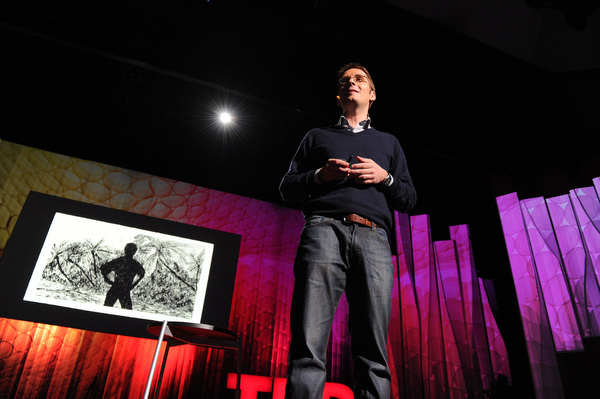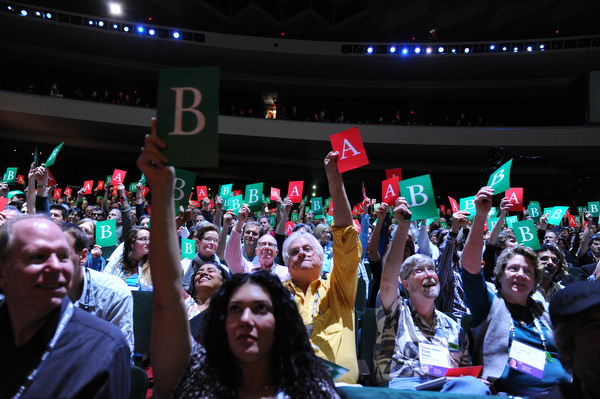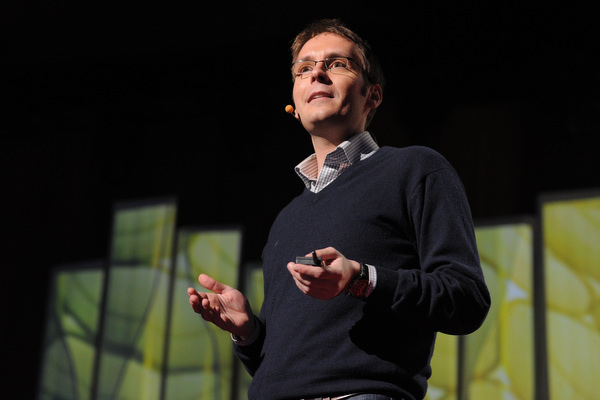Photos: James Duncan Davidson
Sebastian Wernicke thinks there’s something missing from the Full Spectrum of TED2012: The audience has had no influence over the talks.
This is in the vein of the old Choose Your Own Adventure books, invented by accident by Edward Packard. Wernicke is going to tell us that story, but he needs some help deciding how to tell it. The audience has been given two cards, “A” and “B” and he asks them to vote on how the talk should proceed. (He practices by asking the audience to accept a license agreement.)
Should he tell it through eyes of Edward, or his two daughters? (Audience says: Daughters.)
Packard told stories to his daughters. They were about a guy named Pete who had adventures on an island. But one fateful night, he ran out of ideas. Packard asked them what Pete should do next. His daughters had ideas, but they disagreed tremendously, and forced him to tell two different stories. That led him to the idea of Choose Your Own Adventure. The books became highly successful.
Should he talk about the success through the lens of facts or emotion. (Audience says: Emotion).
Packard received tons of letters from children who loved the books. Even the endings in which characters ended up dead. Children were perfectly able to cope with dark endings, a fact that fascinates Wernicke.
Oddly, this format has never spread beyond children and teenage books. It’s never spread to TED, but Wernicke thinks it should.
Should he continue the talk with the slides colored mauve or jade? (Audience says: Jade).
For instance, Wernicke thinks there could be a TED pre-talk, where we ask you what you prefer. For instance, quiet or expressive? (Audience says: Expressive); idealistic or detailed? (Audience says: Idealistic); personal or analytical? (Audience says: Personal)
That produced the title of next year’s TEDTalk: Here are the undiscovered hype generators.
Now, of course, there is a real danger in replacing serendipity with fulfilled expectations. Is there an inherent contradiction here? Are you not in fact coming here by choice?
How to visualize the talk, with circles or trees? (Audience says: Trees)
Wernicke shows several trees to visualize the map of Choose Your Own Adventure books. The early ones were very complicated; the later ones much simpler, often with only one good ending. In one of the later Choose Your Own Adventure books, where you’re looking for a planet of paradise, Packard included an ending you can reach, but not from any other chapter. To get there, you have to violate the rules, and make your own choices.
And with that, Wernicke asks the audience which TED commandement he should violate: “Don’t sell books”, or “Have good slides.” But he then refused to let the audience choose, and showed the worst-designed slide in TED history.
The final question:
Should there be more interactive TEDTalks? (Audience says: Yes, but barely.)
See also: Sebastian’s previous TEDTalks on how to summarize 1000 TEDTalks in six words, and his (silly and wonderful) analysis of how to give the perfect TEDTalk, Lies, damned lies and statistics (about TEDTalks).



Comments (1)